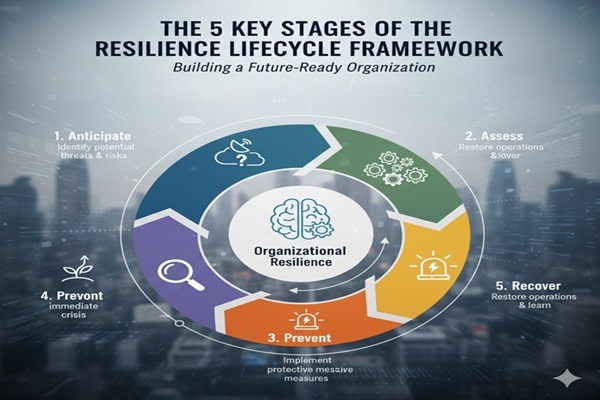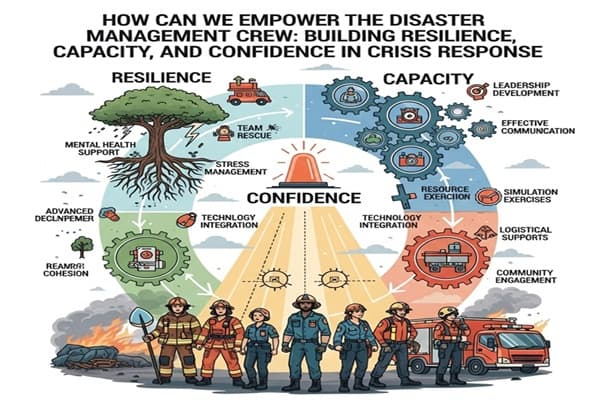What Are the 5 Key Stages of the Resilience Lifecycle Framework?

In today’s fast-paced, unpredictable world, resilience is no longer just a buzzword—it’s a survival skill, a growth strategy, and, ultimately, a way to thrive. But resilience isn’t something you simply “have” or “don’t have.” It’s a dynamic process that evolves over time, shaped by experiences, preparation, and reflection.
Experts have broken this process into a resilience lifecycle framework, which identifies five stages that guide individuals, organizations, and communities from vulnerability to recovery, growth, and transformation. Understanding this framework gives you a roadmap for navigating challenges more effectively.
Let’s dive into the five stages, how they work in real life, and why they matter for personal, professional, and societal resilience.
Why the Resilience Lifecycle Framework Matters
Resilience is often portrayed as a single moment of triumph—a personal story of overcoming adversity or a company bouncing back from crisis. But in reality, resilience is a continuous, cyclical process, not a one-time achievement.
The resilience lifecycle framework helps us see this ongoing journey in a structured way. Here’s why it matters:
-
From survival to thriving: It shows that resilience isn’t just about bouncing back, but bouncing forward.
-
Targeted action: It highlights where interventions or preparation are most effective.
-
Shared understanding: It gives individuals, teams, and policymakers a common language to discuss resilience.
-
Adaptable to context: Whether it’s a pandemic, career setback, or natural disaster, the stages remain consistent across domains.
Stage 1: Anticipation and Preparedness
The first stage is all about foresight. Resilience starts before a disruption even occurs. Anticipation and preparedness involve proactively identifying risks and taking steps to reduce vulnerability.
Key Components
-
Risk Identification: Map potential threats and vulnerabilities. For companies, this could mean scenario planning; for individuals, understanding stress triggers or financial risks.
-
Resource Allocation: Ensure emotional, financial, technological, and human resources are ready to buffer against challenges.
-
Skill Building: Develop adaptability, problem-solving, and emotional regulation to respond effectively.
-
Planning and Communication: Set up clear protocols and channels to enable fast, coordinated responses.
Why It Matters
Preparation pays off. Studies show communities that invest in preparedness recover faster after disasters. Similarly, individuals who practice coping strategies and maintain support networks handle stress more effectively.
Stage 2: Shock or Disruption
No matter how prepared you are, disruptions are inevitable. This stage represents the moment when resilience is tested.
Key Characteristics
-
Immediate Impact: The event disrupts normal functioning, causing stress or operational challenges.
-
Decision-Making Under Pressure: Quick, high-stakes choices must be made, often with incomplete information.
-
Emotional and Physical Responses: Individuals may feel fear or anxiety; organizations may face operational and communication breakdowns.
The Resilience Challenge
The real test is using preparation to stay calm, focused, and responsive, avoiding panic or paralysis. How you navigate this stage largely determines the trajectory of recovery.
Stage 3: Response and Stabilization
Once the shock has hit, the focus shifts to response and stabilization. This is the phase where immediate damage is contained, and systems—or emotions—are stabilized.
Critical Actions
-
Damage Control: Mitigate urgent risks and stabilize operations or emotional states.
-
Mobilize Resources: Activate support networks, contingency plans, and necessary resources.
-
Communication: Maintain clear, transparent messaging to foster trust and coordination.
Examples
-
Disasters: Deploy emergency services, restore critical infrastructure, or set up temporary shelters.
-
Personal Crises: Seek therapy, lean on support networks, or practice mindfulness techniques.
Stage 4: Recovery and Adaptation
Recovery is more than returning to normal. In this stage, individuals and systems reflect, learn, and adapt to emerge stronger.
Important Dimensions
-
Rehabilitation: Restore physical, emotional, or operational functions.
-
Reflection: Analyze what happened, identify vulnerabilities, and note successes.
-
Adaptation: Adjust policies, habits, or systems to prepare for future disruptions.
Why Adaptation Is Key
Without adaptation, resilience is fragile. Learning from challenges and integrating those lessons into future planning creates a feedback loop that strengthens anticipation and preparedness.
Stage 5: Growth and Transformation
The final stage moves beyond recovery into growth and transformation. Resilience isn’t just bouncing back—it’s bouncing forward.
Hallmarks of this Stage
-
Innovative Change: Use adversity as a catalyst for improvements, cultural shifts, or systemic change.
-
Sustained Resilience: Embed resilience as a continuous practice within individuals, organizations, and communities.
-
Empowerment: Build confidence, autonomy, and collective efficacy.
Real-World Applications
-
Communities: Redesign urban infrastructure to withstand future natural disasters.
-
Individuals: Discover new purpose, develop stronger relationships, or enhance emotional intelligence.
-
Organizations: Implement new technologies or policies that reshape business models for long-term stability.
Integrating the Framework: A Holistic Perspective
The five stages are interconnected, not isolated. True resilience comes from continuously revisiting each stage:
-
Reassessing risks based on experience
-
Strengthening response strategies for new types of shocks
-
Embedding recovery lessons into policies or personal habits
-
Pursuing transformative growth as an ongoing practice
Resilience is a journey, not a destination. The lifecycle framework reflects this continuous cycle of learning, adapting, and evolving.
Also Read : Qushvolpix: A Lifestyle Brand for the Design-Conscious Digital Generation
The Human Side of Resilience
At its core, resilience is deeply human. It’s about how people cope, adapt, and thrive amid challenges.
Emotional Resilience
Managing anxiety in anticipation, regulating emotions during shocks, and harnessing hope during recovery and growth.
Social Resilience
Support networks of family, friends, or colleagues are critical at every stage, providing encouragement, guidance, and resources.
Psychological Resilience
Cognitive flexibility, problem-solving skills, and reflective thinking help individuals navigate uncertainty effectively across all lifecycle stages.
Resilience in Organizations and Communities
Resilience scales beyond individuals. Organizations and communities experience similar stages but on a larger, more complex scale.
Corporate Resilience
-
Anticipation: Risk management, scenario planning
-
Shock: Market disruptions, cyber threats
-
Response: Crisis teams and communication strategies
-
Recovery: Continuity planning and employee support
-
Growth: Innovation, digital transformation, and cultural evolution
Community Resilience
-
Anticipation: Disaster preparedness drills, infrastructure investment
-
Shock: Natural disasters or pandemics
-
Response: Emergency services mobilization
-
Recovery: Rehabilitation and public health campaigns
-
Growth: Urban redesign and policy reforms
Measuring Resilience Across the Lifecycle
Quantifying resilience helps target interventions. Metrics may include:
-
Preparedness: Training completion, resource availability
-
Response: Speed and effectiveness of crisis containment
-
Recovery: Time to restore operations or well-being
-
Adaptation: Implementation of post-crisis improvements
-
Growth: Long-term progress in skills, systems, or structures
Continuous measurement creates feedback loops that strengthen future resilience.
Challenges and Criticisms
While widely used, the framework isn’t perfect:
-
Overemphasis on individual responsibility: Risks ignoring systemic issues.
-
Context variability: Stages may not apply linearly across cultures or situations.
-
Resource inequality: Not everyone has equal access to resources for each stage.
These critiques highlight the importance of equity and flexibility in resilience planning.
Building Your Own Resilience Lifecycle Plan
Creating a personal or organizational resilience plan is transformative:
-
Assess risks and vulnerabilities honestly
-
Develop preparedness strategies and stock resources
-
Create response protocols for immediate crises
-
Plan recovery with clear goals and support networks
-
Commit to continuous growth through adaptation and learning
Conclusion: Resilience as a Lifelong Process
Resilience is not just about surviving disruptions—it’s about thriving through them. The five stages of the resilience lifecycle—anticipation, shock, response, recovery, and growth—offer a roadmap for individuals, organizations, and communities to navigate uncertainty effectively.
By viewing resilience as a dynamic, continuous process, we move beyond the idea of toughness and focus on preparation, reflection, adaptation, and transformation. Resilience becomes a proactive, ongoing practice—a cornerstone for sustainable success in an unpredictable world.
FAQs
1. What is the resilience lifecycle framework?
It’s a structured model outlining the five stages that guide individuals, organizations, or communities through building and maintaining resilience.
2. What are the five key stages?
Anticipation and Preparedness, Shock or Disruption, Response and Stabilization, Recovery and Adaptation, Growth and Transformation.
3. How does anticipation improve resilience?
It allows early identification of risks, allocation of resources, and skill development to enable faster, more effective crisis responses.
4. Why is growth and transformation important?
It turns recovery into evolution, enabling learning, innovation, and long-term resilience.
5. Can the framework be applied broadly?
Yes. It works for individuals, organizations, and communities, offering a universal approach to navigating adversity and fostering sustainable growth.
community resilience crisis management growth and transformation organizational resilience personal resilience preparedness recovery and adaptation resilience lifecycle framework resilience stages thriving through adversity
Last modified:


